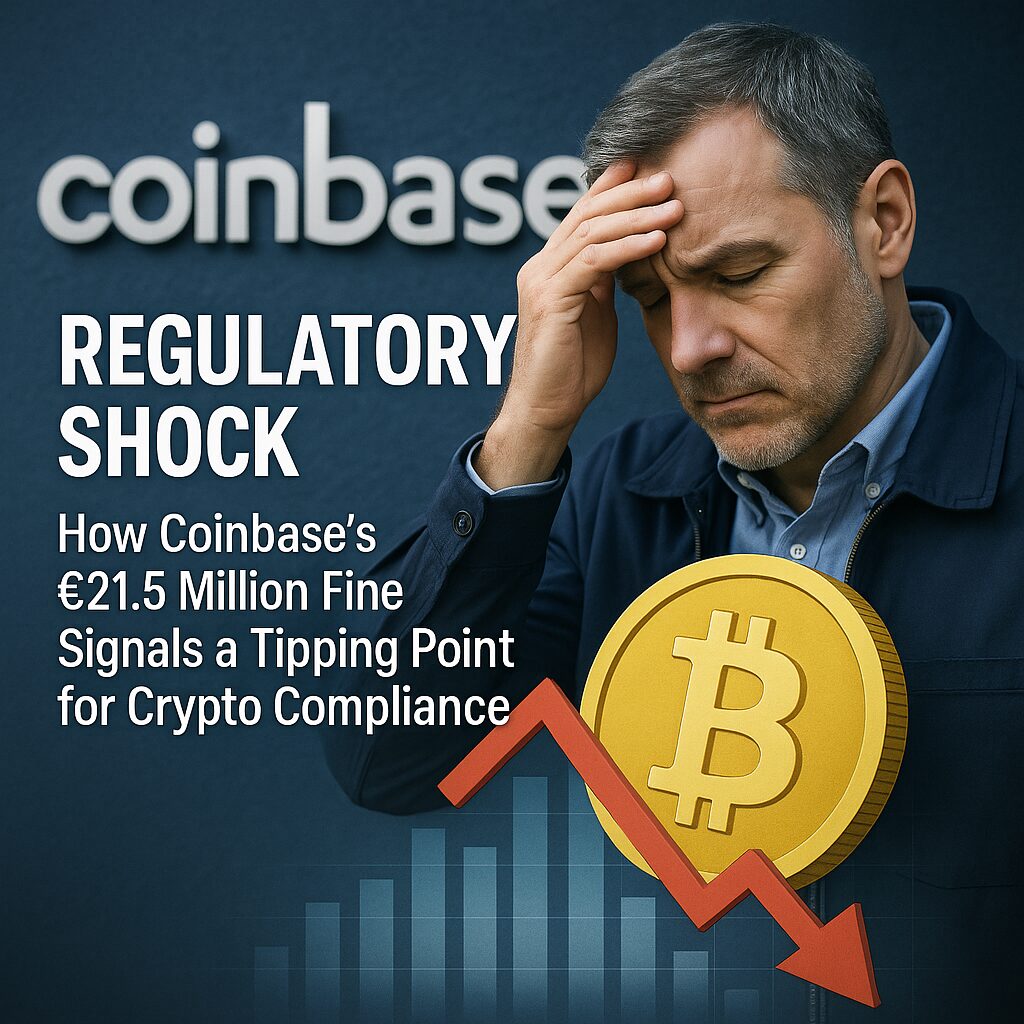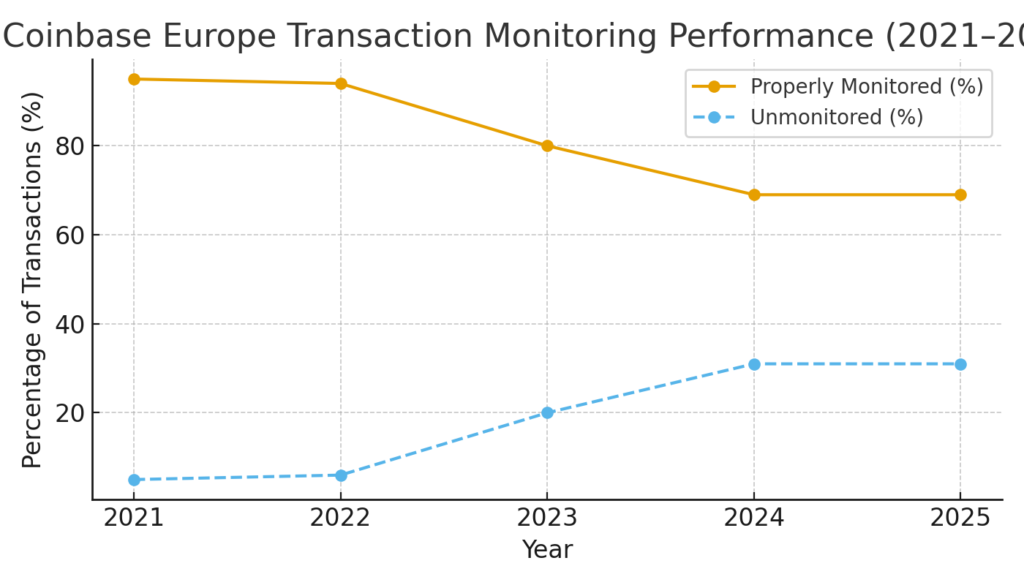
Key Points :
- The Central Bank of Ireland (CBI) imposed a €21.5 million (≈ US $25 million) fine on Coinbase Europe Limited for systemic failures in transaction monitoring between 2021 and 2023/2025.
- Over 30 million transactions – equating to about €176 billion (≈ US $203 billion) – representing around 31% of Coinbase Europe’s volume during the lapse period, went unmonitored.
- The lapses stemmed from three coding errors in Coinbase’s transaction-monitoring system (“TMS”) which caused five out of 21 scenarios to fail to fully screen certain crypto-wallet address formats (e.g., special characters).
- Following remediation, roughly 185,000 transactions were flagged for further review and about 2,700 Suspicious Transaction Reports (STRs) were filed, covering approximately €13 million in transactions potentially linked with money-laundering, fraud, drug-trafficking, cyber-attacks and child sexual exploitation.
- The fine marks the first major crypto-sector enforcement by the CBI and signals a broader regulatory tightening across Europe ahead of the full rollout of the Markets in Crypto‑Assets Regulation (MiCAR).
1. The Breach: What Went Wrong at Coinbase Europe

Between April 2021 and March 2023 (or through March 2025 by some accounts), Coinbase Europe failed to properly monitor a significant portion of transactions flowing through its platform. The CBI found that during a 12-month period roughly 31% of all its transactions—over 30 million in number and valued at about €176 billion—were inadequately screened.
The root cause was internal: Coinbase admitted to three coding errors in its TMS that meant five of its 21 monitoring scenarios did not fully perform. One illustrative technical fault: the system failed to detect wallet addresses containing certain special characters (“&”, etc.).
Because these flaws went unnoticed for a protracted period, the compliance breakdown extended beyond mere mis-configurations. Coinbase acknowledged it also failed to adopt and maintain adequate internal policies, controls and procedures for AML/CTF (anti-money-laundering / counter terrorist-financing) purposes.
Moreover, the very process of remediation took nearly three years; the full rescreening of impacted transactions was only completed recently, meaning the risk window remained open for some time.
For practitioners and crypto investors alike, the lesson is clear: the technological and compliance layers of crypto operations operate in tandem. A glitch in monitoring software can cascade into a major regulatory event.
2. The Regulatory Message: Why It Matters for Crypto Investors and Infrastructure

From the regulator’s perspective, this case is highly significant. The fine remains relatively modest in absolute size for a major global crypto exchange—but its symbolic weight is strong. The CBI stated explicitly:
“Crypto has particular technological features which, together with its anonymity-enhancing capabilities and cross-border nature, makes it especially attractive to criminals looking to move their funds.”
In other words, the regulatory bar for VASPs (Virtual Asset Service Providers) is being elevated. Firms can no longer rely solely on generic financial-services compliance frameworks; they must account for the unique risk vectors inherent in crypto: decentralisation, anonymity tools, peer-to-peer transfers, rapid cross-border flows.
For investors and developers—especially those building new protocols, DEXes, wallets, or launching tokens—the implications are immediate. Regulatory infrastructure (monitoring, reporting, transaction screening) is not optional. Even failures that do not definitively result in crime can trigger regulatory action.
Furthermore, with MiCAR coming into full force in the EU, this enforcement serves as an early-warning: national regulators will make examples of first movers.
Finally, from an ecosystem-perspective, this may accelerate shifts such as:
- Exchanges relocating their EU base (notably, Coinbase is establishing operations in Luxembourg as of year-end).
- Higher compliance costs being baked into business models (including for token issuers, wallets, payment rails).
- Potential flight or suppression of smaller players that cannot afford full monitoring infrastructure, opening space for new entrants with built-in compliance-first architectures.
3. Implications for Token Projects, Wallets & DeFi Practitioners
For the reader focused on new crypto assets, income opportunities and blockchain use-cases, this case has several practical take-aways:
• Token issuers and launch platforms
If you are launching a token (e.g., an ICO or presale), or developing a no-code launchpad, you must consider not only the token technicalities (ERC-20, SPL, viral mechanics) but the post-distribution compliance regime: who monitors transfers, who screens participants, how suspicious patterns are flagged. An exchange or platform failure in this layer might result in regulatory liabilities downstream.
• Wallets and swap services
As you develop or design a wallet (you mentioned your non-custodial wallet “dzilla Wallet”), the governance of swap functions, KYC/AML bridging, and transaction-monitoring (even for non-custodial context) may increasingly be subject to regulatory scrutiny. While non-custodial by design, if you facilitate swap of assets or integrate fiat on-ramp, oversight may still apply.
• DeFi & trading income opportunities
From the investor side, regulatory risk becomes a non-negligible variable. Projects tied to platforms or jurisdictions with weak compliance may face retroactive enforcement, reputational damage, or asset freezes. On the flip side, platforms that proactively embed strong compliance mechanisms may attract institutional flows and higher-quality users.
• Geographic arbitrage and regulatory migration
Coinbase’s plan to move operations from Ireland to Luxembourg underscores that regulatory jurisdictions matter. Token projects or services may benefit from selecting jurisdictions with transparent crypto-asset regulation, but must still assume that global flows will bring local regulator interest. Jurisdiction-shopping alone won’t insulate from scrutiny.
4. What’s Next? Trends & Strategic Considerations
Looking ahead, there are several trends likely to accelerate:
- Stronger enforcement across Europe and beyond: This case is early but likely not isolated. Other national regulators will follow. The EU AML Package and MiCAR regime will raise the stakes for crypto-asset service providers.
- Technology failures become compliance failures: In crypto infrastructure, code errors (like Coinbase’s mis-filtering of special characters) now trigger liability. Software-governance, system-integrity and auditability of monitoring systems will become key value drivers.
- Compliance as competitive edge: Platforms which publicly demonstrate robust transaction-monitoring, suspicious-activity-reporting (SAR) processes and governance will increasingly win trust, institutional volume and premium valuations.
- Token projects inherit counter-party risk: Even if your token is decentralised, if it depends on exchanges, wallets, or service providers that fail compliance, the token can suffer collateral damage. Token projects should evaluate their ecosystem partners’ compliance maturity.
- Incumbent-crypto convergence: As traditional finance enters crypto more fully (payments, asset-backed tokens, stablecoin rails), the regulatory expectations from incumbents will carry over. Crypto-native firms must meet similar standards to banks in monitoring and reporting.
5. Conclusion: A Wake-Up Call for the Crypto Ecosystem
The CBI’s fine against Coinbase Europe is not just a one-off penalty—it comprises a symbolic and strategic warning shot for the entire crypto industry. For both builders and investors, the message is clear: crypto’s innovative promise cannot ignore the compliance imperative.
If you’re hunting for new crypto assets or building practical blockchain utilities, embed compliance-thinking from day one. Whether you’re launching a token, designing a wallet, building a swap function, or simply choosing an exchange partner, you must ask:
- How are transactions monitored?
- What controls flag suspicious behaviours (industry links: fraud, laundering, exploitation)?
- Is my counter-party licensed or subject to strong regulator oversight?
- If code fails, do we have procedures to respond and rescreen?
In an era where regulators view token flows and wallet addresses as potential conduits for crime, the robustness of your infrastructure is a plugged-in risk mitigator—and a source of competitive advantage.
For readers scanning for the next income opportunity or build-out path: the compliance-savvy platform may outlast the hype-driven one. The regulatory layer is now part of the fundamental architecture of crypto finance—not peripheral.

